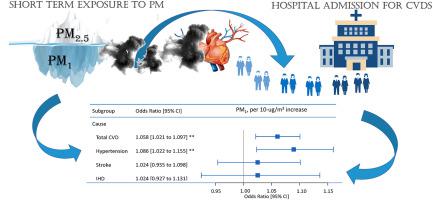Atmospheric Environment ( IF 5 ) Pub Date : 2021-02-17 , DOI: 10.1016/j.atmosenv.2021.118271 Yuanyuan Zhang , Liansheng Zhang , Jing Wei , Linjiong Liu , Yaqi Wang , Jiaxin Liu , Peixuan Zhou , Lu Wang , Zan Ding , Yunquan Zhang

|
Background
Despite contributing to the majority of ambient fine particles (PM2.5), PM1 (particulate matter [PM] with aerodynamic diameter ≤1 μm) remains poorly studied in terms of its acute effects on cardiovascular diseases (CVDs) in China. This study aims to evaluate the short-term associations of size-specific PMs (i.e., PM1, PM2.5, and PM10) exposures with hospital admissions for CVDs in a southern Chinese metropolis.
Methods
We collected 5,969 records of hospital admissions for CVDs and daily average concentrations of air pollutants and weather conditions in Shenzhen from January 1st 2015 to December 31st 2017. We adopted a time-stratified case-crossover design and conditional logistic regression models to assess short-term associations between size-specific PMs and CVD hospitalizations along different exposure days.
Results
During the study period, annual average concentrations of PM1, PM2.5, and PM10 were 18.7, 27.8, and 45.4 μg/m3, respectively. Compared to PM2.5 and PM10, PM1 exhibited a generally stronger association with CVD hospitalizations. Hospital admissions for CVDs increased by 6.7% (95% confidence interval: 1.2–12.5%), 4.5% (0.4–8.7%), and 3.4% (0.5–6.3%), corresponding to per 10-μg/m3 rise in exposure to PM1, PM2.5, and PM10 at lag 03 days. In our stratified analyses by CVD sub-causes, size-specific PMs showed consistent effects on hypertension but no evident association with ischemic heart disease (IHD) and stroke. Seasonal analysis revealed significantly larger PM-associated risks among IHD patients in cold months (October–March). Nevertheless, in warm months (April–September), the older group (aged 65+ years) was more prone to adverse effects of PM1 exposure at lag 0 day.
Conclusion
Short-term exposure to size-specific PMs, PM1 in particular, may trigger incidences of CVD hospitalization. To effectively mitigate adverse effects of particulate pollution, evidence-based PM1 standards should be developed as well in Chinese less-polluted megacities.

























 京公网安备 11010802027423号
京公网安备 11010802027423号